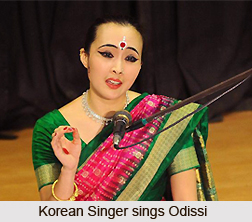 Gamakas in Odissi Music are certain very important elements in the presentation of the musical style. Gamaka actually means the shaking or vibrating of a tone which sounds delightful to listen to. In a melodic structure, the formulation of a tonal shade arising out of a Swara`s own Sruti and resorting to that of another Sruti, is demonstrated to be the Gamaka. According to the Sangeet Ratnakar, the different varieties of Gamaka are: Tiripa, Sphurita, Kamrita, Lina, Andolita, Vali, Tribhinna, Kurula, Ahata, Uttasita, Plavita, Humphita, Mudrita, Narnita, and Misria. After Ratnakar, Pundit Anobal of Sangit Parijat has mentioned twenty types of Gamakas. Bharata, the author of the Natyashastra, does not distinguish between Alamkara and Gamaka.
Gamakas in Odissi Music are certain very important elements in the presentation of the musical style. Gamaka actually means the shaking or vibrating of a tone which sounds delightful to listen to. In a melodic structure, the formulation of a tonal shade arising out of a Swara`s own Sruti and resorting to that of another Sruti, is demonstrated to be the Gamaka. According to the Sangeet Ratnakar, the different varieties of Gamaka are: Tiripa, Sphurita, Kamrita, Lina, Andolita, Vali, Tribhinna, Kurula, Ahata, Uttasita, Plavita, Humphita, Mudrita, Narnita, and Misria. After Ratnakar, Pundit Anobal of Sangit Parijat has mentioned twenty types of Gamakas. Bharata, the author of the Natyashastra, does not distinguish between Alamkara and Gamaka.
The Gamakas can be classified according to duration, range of notes, and special effect created. In Odissi music, mainly four Gamakas are in use, namely, Andolita, Ahata, Dhalu (ascending Dhalu and descending Dhalu) and Ambredita. The nature of speed of Odissi music is Andolita. This Andolita Gamaka is a classical Gamaka system. In this process, the Swara is not stable but vibrating. Andolita Gamak manifests its beauty with the help of Ahata Gamak. The most essential characteristics of Ahata gamak is to sing a particular Swara with the touch of its next ascending note. Another gamak is dhalu, which is used in ascending and descending process. This Gamak is mainly used in the recitation of Odissi Raaga music. Ambredita Gamak is a traditional and special Gamaka of Odissi. This Gamaka is used very frequently. It finishes its cycle with one matra and is always descending in nature. It is in fast pace. The four major Gamakas are defined below:
Andolita - sa re ga ma
Ahata - sa re ga ma
Arohi dhalu - mapapaninisa
Abarohi dhalu - sani nidha dhapa ..
Ambredita - nisaniresani, gamagapamaga,
regaremagare, padhapasanidhapa
This article is a stub. You can enrich by adding more information to it. Send your Write Up to [email protected]




